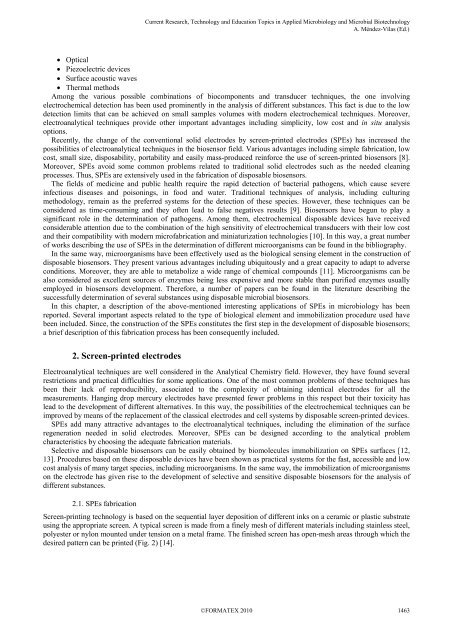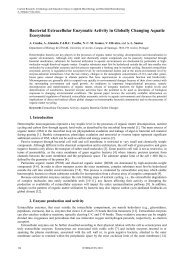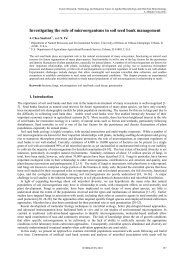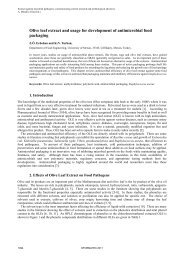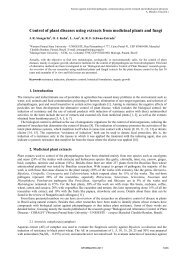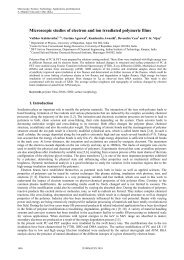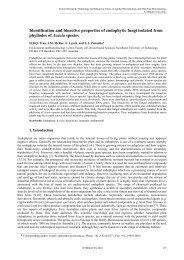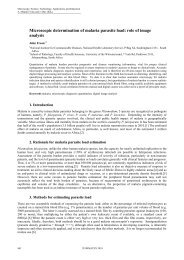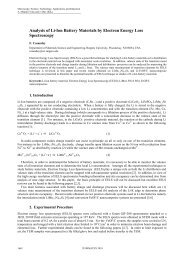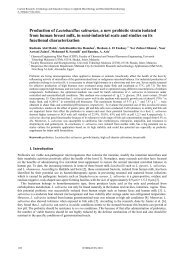Disposable electrochemical biosensors in microbiology - Formatex ...
Disposable electrochemical biosensors in microbiology - Formatex ...
Disposable electrochemical biosensors in microbiology - Formatex ...
Create successful ePaper yourself
Turn your PDF publications into a flip-book with our unique Google optimized e-Paper software.
• Optical<br />
• Piezoelectric devices<br />
• Surface acoustic waves<br />
• Thermal methods<br />
Among the various possible comb<strong>in</strong>ations of biocomponents and transducer techniques, the one <strong>in</strong>volv<strong>in</strong>g<br />
<strong>electrochemical</strong> detection has been used prom<strong>in</strong>ently <strong>in</strong> the analysis of different substances. This fact is due to the low<br />
detection limits that can be achieved on small samples volumes with modern <strong>electrochemical</strong> techniques. Moreover,<br />
electroanalytical techniques provide other important advantages <strong>in</strong>clud<strong>in</strong>g simplicity, low cost and <strong>in</strong> situ analysis<br />
options.<br />
Recently, the change of the conventional solid electrodes by screen-pr<strong>in</strong>ted electrodes (SPEs) has <strong>in</strong>creased the<br />
possibilities of electroanalytical techniques <strong>in</strong> the biosensor field. Various advantages <strong>in</strong>clud<strong>in</strong>g simple fabrication, low<br />
cost, small size, disposability, portability and easily mass-produced re<strong>in</strong>force the use of screen-pr<strong>in</strong>ted <strong>biosensors</strong> [8].<br />
Moreover, SPEs avoid some common problems related to traditional solid electrodes such as the needed clean<strong>in</strong>g<br />
processes. Thus, SPEs are extensively used <strong>in</strong> the fabrication of disposable <strong>biosensors</strong>.<br />
The fields of medic<strong>in</strong>e and public health require the rapid detection of bacterial pathogens, which cause severe<br />
<strong>in</strong>fectious diseases and poison<strong>in</strong>gs, <strong>in</strong> food and water. Traditional techniques of analysis, <strong>in</strong>clud<strong>in</strong>g cultur<strong>in</strong>g<br />
methodology, rema<strong>in</strong> as the preferred systems for the detection of these species. However, these techniques can be<br />
considered as time-consum<strong>in</strong>g and they often lead to false negatives results [9]. Biosensors have begun to play a<br />
significant role <strong>in</strong> the determ<strong>in</strong>ation of pathogens. Among them, <strong>electrochemical</strong> disposable devices have received<br />
considerable attention due to the comb<strong>in</strong>ation of the high sensitivity of <strong>electrochemical</strong> transducers with their low cost<br />
and their compatibility with modern microfabrication and m<strong>in</strong>iaturization technologies [10]. In this way, a great number<br />
of works describ<strong>in</strong>g the use of SPEs <strong>in</strong> the determ<strong>in</strong>ation of different microorganisms can be found <strong>in</strong> the bibliography.<br />
In the same way, microorganisms have been effectively used as the biological sens<strong>in</strong>g element <strong>in</strong> the construction of<br />
disposable <strong>biosensors</strong>. They present various advantages <strong>in</strong>clud<strong>in</strong>g ubiquitously and a great capacity to adapt to adverse<br />
conditions. Moreover, they are able to metabolize a wide range of chemical compounds [11]. Microorganisms can be<br />
also considered as excellent sources of enzymes be<strong>in</strong>g less expensive and more stable than purified enzymes usually<br />
employed <strong>in</strong> <strong>biosensors</strong> development. Therefore, a number of papers can be found <strong>in</strong> the literature describ<strong>in</strong>g the<br />
successfully determ<strong>in</strong>ation of several substances us<strong>in</strong>g disposable microbial <strong>biosensors</strong>.<br />
In this chapter, a description of the above-mentioned <strong>in</strong>terest<strong>in</strong>g applications of SPEs <strong>in</strong> <strong>microbiology</strong> has been<br />
reported. Several important aspects related to the type of biological element and immobilization procedure used have<br />
been <strong>in</strong>cluded. S<strong>in</strong>ce, the construction of the SPEs constitutes the first step <strong>in</strong> the development of disposable <strong>biosensors</strong>;<br />
a brief description of this fabrication process has been consequently <strong>in</strong>cluded.<br />
2. Screen-pr<strong>in</strong>ted electrodes<br />
Electroanalytical techniques are well considered <strong>in</strong> the Analytical Chemistry field. However, they have found several<br />
restrictions and practical difficulties for some applications. One of the most common problems of these techniques has<br />
been their lack of reproducibility, associated to the complexity of obta<strong>in</strong><strong>in</strong>g identical electrodes for all the<br />
measurements. Hang<strong>in</strong>g drop mercury electrodes have presented fewer problems <strong>in</strong> this respect but their toxicity has<br />
lead to the development of different alternatives. In this way, the possibilities of the <strong>electrochemical</strong> techniques can be<br />
improved by means of the replacement of the classical electrodes and cell systems by disposable screen-pr<strong>in</strong>ted devices.<br />
SPEs add many attractive advantages to the electroanalytical techniques, <strong>in</strong>clud<strong>in</strong>g the elim<strong>in</strong>ation of the surface<br />
regeneration needed <strong>in</strong> solid electrodes. Moreover, SPEs can be designed accord<strong>in</strong>g to the analytical problem<br />
characteristics by choos<strong>in</strong>g the adequate fabrication materials.<br />
Selective and disposable <strong>biosensors</strong> can be easily obta<strong>in</strong>ed by biomolecules immobilization on SPEs surfaces [12,<br />
13]. Procedures based on these disposable devices have been shown as practical systems for the fast, accessible and low<br />
cost analysis of many target species, <strong>in</strong>clud<strong>in</strong>g microorganisms. In the same way, the immobilization of microorganisms<br />
on the electrode has given rise to the development of selective and sensitive disposable <strong>biosensors</strong> for the analysis of<br />
different substances.<br />
2.1. SPEs fabrication<br />
_______________________________________________________________________________________<br />
Screen-pr<strong>in</strong>t<strong>in</strong>g technology is based on the sequential layer deposition of different <strong>in</strong>ks on a ceramic or plastic substrate<br />
us<strong>in</strong>g the appropriate screen. A typical screen is made from a f<strong>in</strong>ely mesh of different materials <strong>in</strong>clud<strong>in</strong>g sta<strong>in</strong>less steel,<br />
polyester or nylon mounted under tension on a metal frame. The f<strong>in</strong>ished screen has open-mesh areas through which the<br />
desired pattern can be pr<strong>in</strong>ted (Fig. 2) [14].


